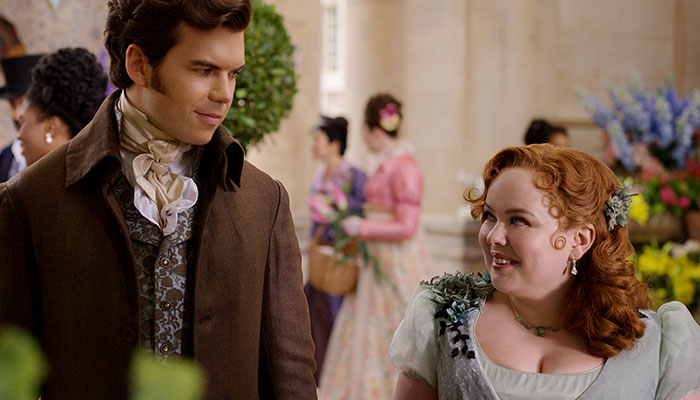Adapted from author Julia Quinn’s long-running romance series, Bridgerton season three focuses on Penelope Featherington’s (played by Nicola Coughlan) romance with the third dashing Bridgerton brother, Colin (Luke Newton). Viewers should expect more of the drama and romance that steamed up our screens in the first two outings and the spin-off, Queen Charlotte.

Slow burn: Colin Bridgerton (played by Luke Newton) and Penelope Featherington (played by Nicola Coughlan) portray a typical Regency couple where propriety must win over emotions.
Our appetite for Regency romance, both in print and on the screen, seems insatiable. But what is it about the Regency Era, exactly, that makes it just so … sexy?
What and when was the Regency Era?
The Regency is the name given to the period from 1811 to 1820, as the Prince of Wales, the son of King George III, had to take over the Crown when his father succumbed to mental illness. He became known as the Prince Regent until the death of his father in 1820, when he then became King George IV.
So was the Prince Regent as dashing as a Bridgerton?
In a word, no. The Prince Regent was wildly unpopular, and liked to spend money. He was also not very fond of his wife, whom he tried unsuccessfully to divorce, but very fond of his mistresses. In fact, he even tried to marry one, Maria Fitzherbert, although the marriage was not legal as his father did not give his consent. His reign was marred by scandal and financial troubles, and nobody thought he was particularly attractive.

What is so romantic about the Regency?
The Regency has long been the most popular historical period in which to set a romance for many reasons:
1. Jane Austen
In the popular imagination, romance and empire-line dresses just seem to go hand-in-hand, and we have one person to thank: the greatest romance novelist of all. Jane Austen started writing some of her novels in the 1790s, but all of her novels were published during the Regency.
While Jane Austen would have thought of herself as writing novels of manners, not romance, her novels set the template for the structure and style of the romance novel from then on. It’s no exaggeration to say that every romance novel owes its existence to Jane. And thanks to the cultural ubiquity of the Jane Austen adaptation, we automatically associate tales of historical romance with the aesthetic of the Regency.
2. Suffocating social norms
Dating in the Regency period wasn’t great. You had to be introduced to a man before you could even say hello. If you were caught alone with him, even if the situation was totally innocent, you might have to marry him.
Almost every single one of your interactions would be in public, usually with your parents in attendance. You might have only spoken to a man a handful of times before he proposed.

Chaperones: Social conventions of the Regency Era dictated that young men and women must never be alone in public and were typically accompanied on outings by a parent.
However, on the screen and on the page, all these restrictions mean one thing … tension. You couldn’t just ask somebody out. You couldn’t just tell somebody that you were into them. That meant that everything had to just simmer under the surface, left tantalisingly unsaid. That makes for the perfect situation for long glances across the ballroom, and that means that every little touch or glance becomes meaningful.
3. High stakes
For young ladies of the time, the stakes of the Regency romance are sky-high. As a woman in the Regency period, if you married the wrong man, you couldn’t just ring up your friendly local divorce lawyer to free you from wedlock.
When you married, you became the legal property of your husband, and so did your children. While that is an unthinkable situation from our modern perspective - and certainly alarming to many women at the time - that also meant that the question of who to marry became the most significant decision of a woman’s life.
And if you took too long about deciding – that was also an issue. Consdier Anne, the heroine of Jane Austen’s Persuasion. She’s is regarded as a spinster, left-on-the-shelf, sad and lonely and destined to be alone forever. She’s 27. Anne has the last laugh when tall and handsome Captain Wentworth re-enters her life, but that’s a story for another time.
Of course, women did do things beyond get married like, say, write six of the best novels of all time (hello again Jane). But the opportunities for women beyond marriage were severely curtailed.
4. There’s a lot of Regency romances
While for many Bridgerton might be the first foray into Regency romance on the small screen, the Regency romance novel is still thriving.
Julia Quinn’s Bridgerton series is by no means the only series that Shonda Rhimes, the executive producer of the TV series, could have chosen. While the Regency romance novel definitely looks back at Jane Austen, the twentieth-century novelist Georgette Heyer really invented the genre as we know it now.

Prolific writer: Associate Professor Stephanie Russo, pictured above, recommends the novels of English authors Georgette Heyer and Jane Austen for further exploration of Regency Era social norms.
In 1935, she released the novel Regency Buck, which was a massive bestseller. In fact, it was so successful that she wrote 26 Regency romances in total. Heyer is known for her eye for historical detail, but her characters are really what drew readers into her novels. And so an obsession was born.
If you’re looking for other recommendations, I like Sarah MacLean’s Scandal and Scoundrel series – think, the Kardashians, Regency style. And you really can’t go past Georgette Heyer. I recommend Cotillion, which is funny and delightful, and features perhaps Heyer’s best hero in Freddy Standen.
So when you’re watching Bridgerton, perhaps raise a glass to Jane Austen and Georgette Heyer: they’re the real reason we can’t stop romancing Mr Bridgerton.
Stephanie Russo is an Associate Professor of Literature who specialises in early modern and eighteenth-century women’s writing. Her latest book is The Anachronistic Turn: Historical Fiction, Drama, Television and Film, published by Routledge.



